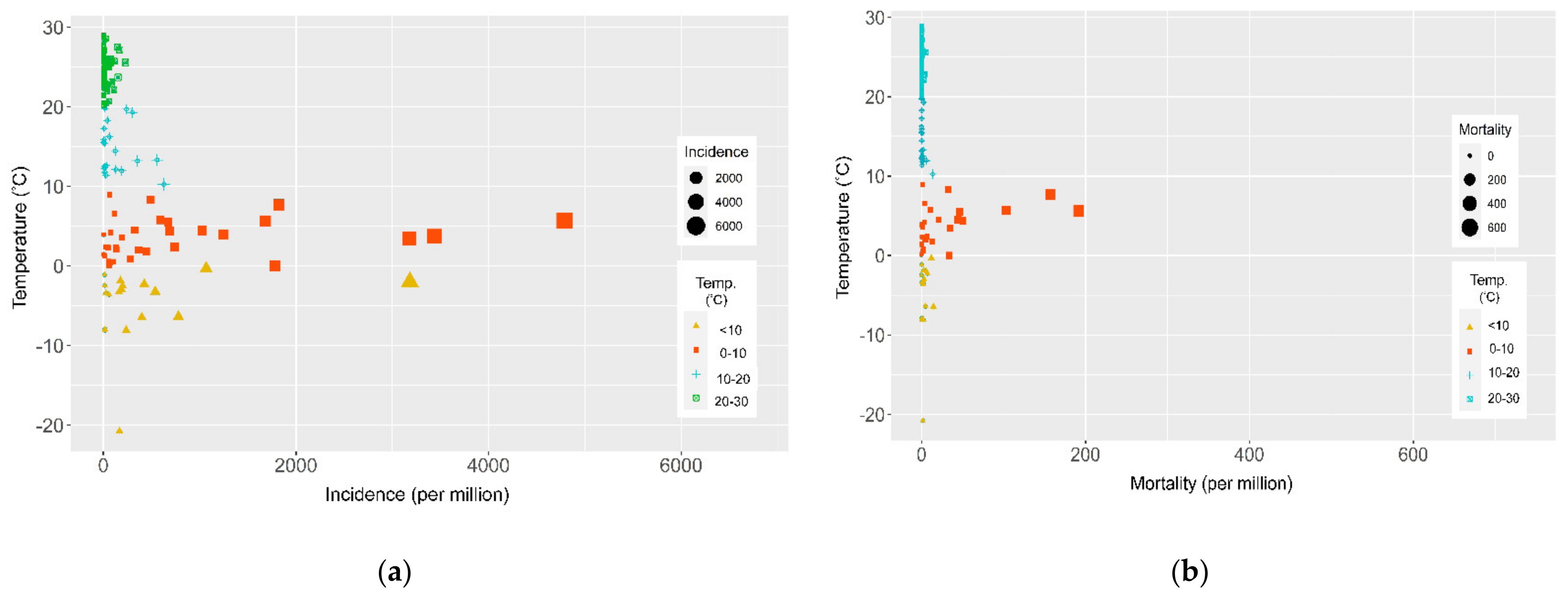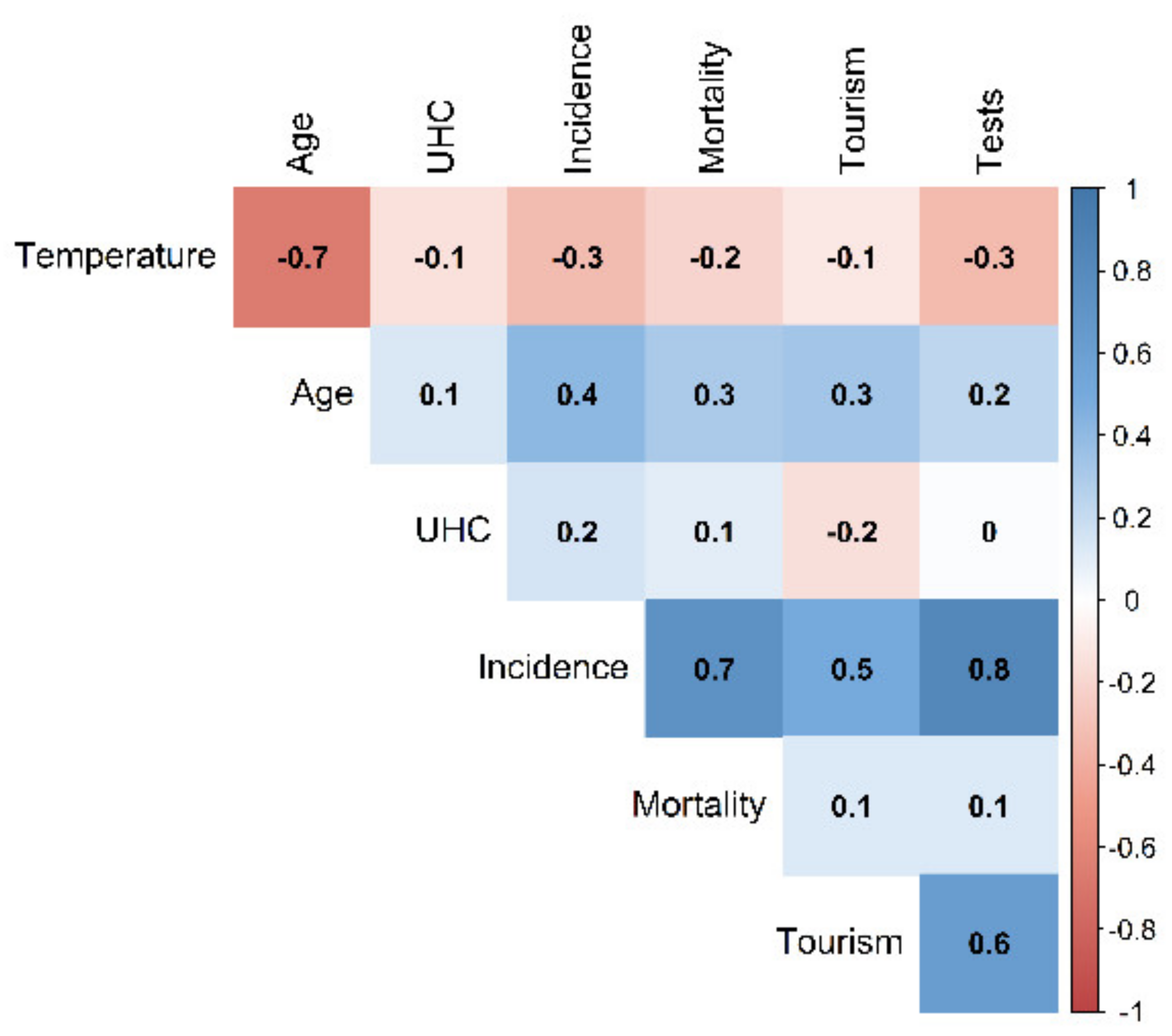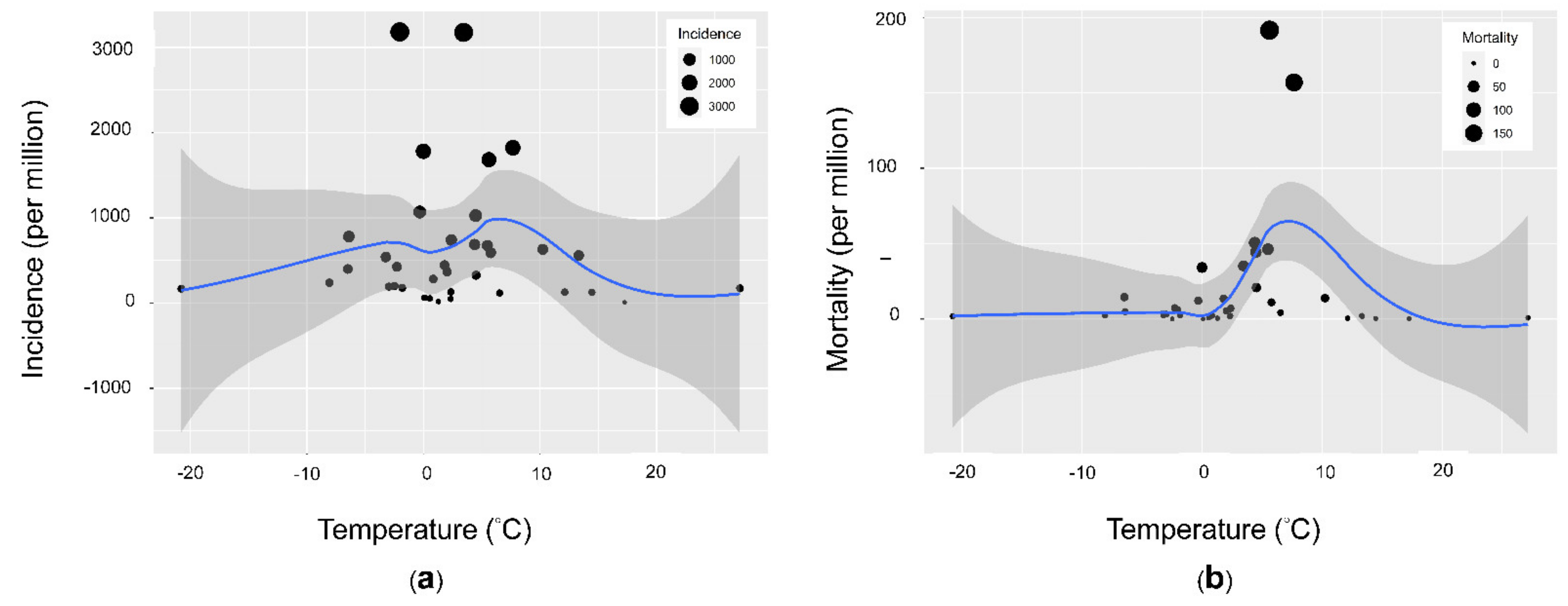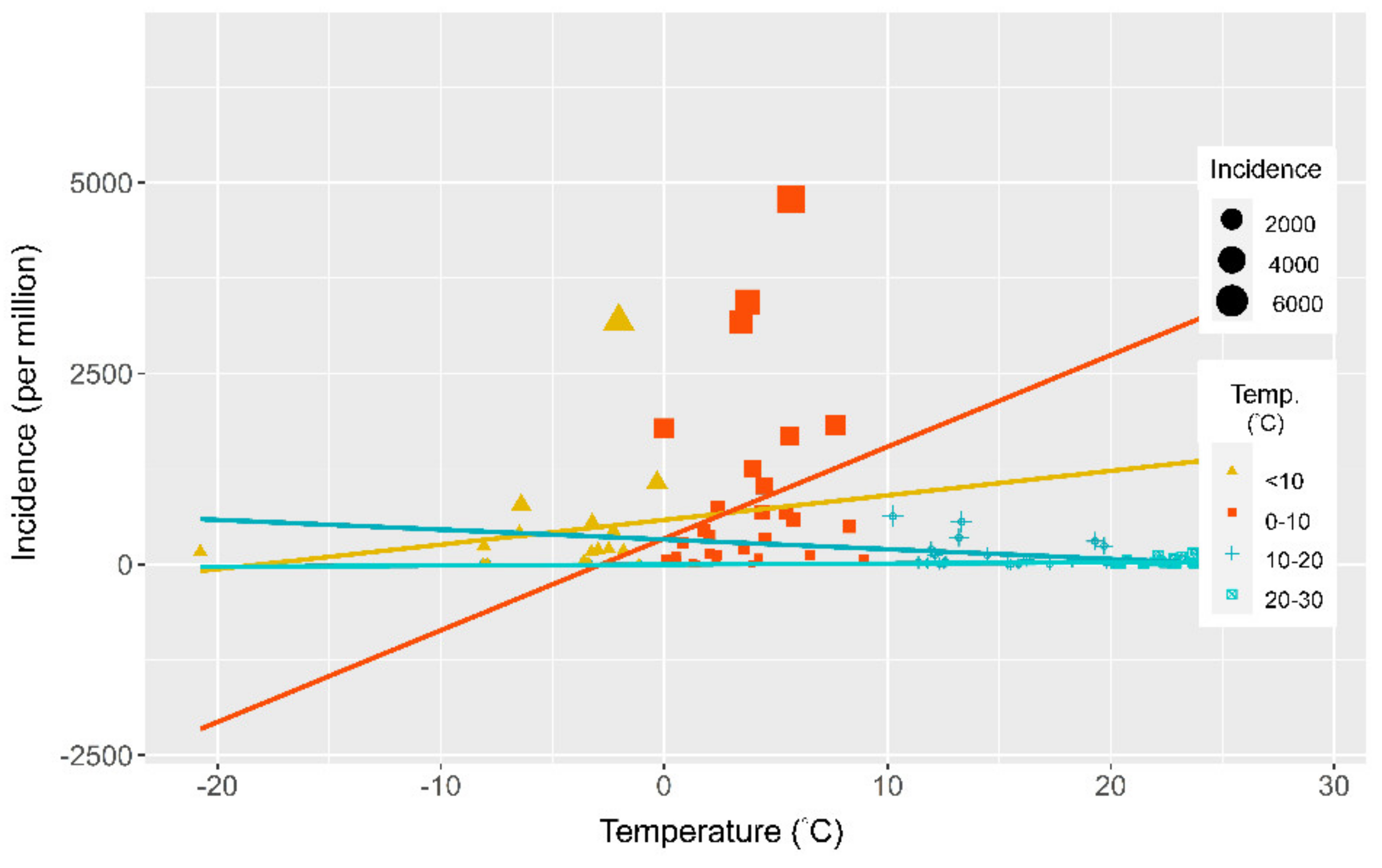The Impact of Temperature on the Risk of COVID-19: A Multinational Study
Abstract
1. Introduction
2. Materials and Methods
2.1. Study Countries and Number of Cases
2.2. Climate, Median Population Age, and International Tourism
2.3. Universal Health Coverage Index
2.4. The SARS-CoV-2 Testing Rate
2.5. Population Density
2.6. Statistical Analysis
3. Results
4. Discussion
5. Conclusions
Supplementary Materials
Author Contributions
Funding
Institutional Review Board Statement
Informed Consent Statement
Data Availability Statement
Acknowledgments
Conflicts of Interest
References
- Mecenas, P.; Bastos, R.; Vallinoto, A.C.R.; Normando, D. Effects of temperature and humidity on the spread of COVID-19: A systematic review. PLoS ONE 2020, 15, e0238339. [Google Scholar] [CrossRef]
- Qi, H.; Xiao, S.; Shi, R.; Ward, M.P.; Chen, Y.; Tu, W.; Su, Q.; Wang, W.; Wang, X.; Zhang, Z. COVID-19 transmission in Mainland China is associated with temperature and humidity: A time-series analysis. Sci. Total Environ. 2020, 728, 138778. [Google Scholar] [CrossRef]
- Liu, J.; Zhou, J.; Yao, J.; Zhang, X.; Li, L.; Xu, X.; He, X.; Wang, B.; Fu, S.; Niu, T.; et al. impact of meteorological factors on the COVID-19 transmission: A multi-city study in China. Sci. Total Environ. 2020, 726, 138513. [Google Scholar] [CrossRef] [PubMed]
- Bashir, M.F.; Ma, B.; Bilal; Komal, B.; Bashir, M.A.; Tan, D.; Bashir, M. Correlation between climate indicators and COVID-19 pandemic in New York, USA. Sci. Total Environ. 2020, 728, 138835. [Google Scholar] [CrossRef] [PubMed]
- Tosepu, R.; Gunawan, J.; Effendy, D.S.; Ahmad, O.A.I.; Lestari, H.; Bahar, H.; Asfian, P. Correlation between weather and Covid-19 pandemic in Jakarta, Indonesia. Sci. Total Environ. 2020, 725, 138436. [Google Scholar] [CrossRef]
- Pung, R.; Chiew, C.J.; Young, B.E.; Chin, S.; Chen, M.I.; Clapham, H.E.; Cook, A.R.; Maurer-Stroh, S.; Toh, M.; Poh, C.; et al. Investigation of three clusters of COVID-19 in Singapore: Implications for surveillance and response measures. Lancet 2020, 395, 1039–1046. [Google Scholar] [CrossRef]
- Sjodin, H.; Wilder-Smith, A.; Osman, S.; Farooq, Z.; Rocklov, J. Only strict quarantine measures can curb the coronavirus disease (COVID-19) outbreak in Italy, 2020. Eurosurveillance 2020, 25, 7–12. [Google Scholar] [CrossRef] [PubMed]
- Fan, C.; Liu, L.; Guo, W.; Yang, A.; Ye, C.; Jilili, M.; Ren, M.; Xu, P.; Long, H.; Wang, Y. Prediction of epidemic spread of the 2019 novel coronavirus driven by spring festival transportation in China: A population-based study. Int. J. Environ. Res. Public Health 2020, 17, 1679. [Google Scholar] [CrossRef]
- Dowd, J.B.; Andriano, L.; Brazel, D.M.; Rotondi, V.; Block, P.; Ding, X.; Liu, Y.; Mills, M.C. Demographic science aids in understanding the spread and fatality rates of COVID-19. Proc. Natl. Acad. Sci. USA 2020, 117, 9696–9698. [Google Scholar] [CrossRef] [PubMed]
- Collaborators, G.S. Measuring progress and projecting attainment on the basis of past trends of the health-related Sustainable Development Goals in 188 countries: An analysis from the Global Burden of Disease Study 2016. Lancet 2017, 390, 1423–1459. [Google Scholar] [CrossRef]
- Reid, M.; Roberts, G.; Goosby, E.; Wesson, P. Monitoring Universal Health Coverage (UHC) in high Tuberculosis burden countries: Tuberculosis mortality an important tracer of UHC service coverage. PLoS ONE 2019, 14, e0223559. [Google Scholar] [CrossRef] [PubMed]
- United Nations. Population Division (2019): World Population Prospects 2019; Online Edition; Rev. 1.; United Nations: New York, NY, USA, 2019. [Google Scholar]
- Collaborators, G.S. Measuring the health-related Sustainable Development Goals in 188 countries: A baseline analysis from the Global Burden of Disease Study 2015. Lancet 2016, 388, 1813–1850. [Google Scholar] [CrossRef]
- Strobl, C.; Boulesteix, A.L.; Kneib, T.; Augustin, T.; Zeileis, A. Conditional variable importance for random forests. BMC Bioinform. 2008, 9, 307. [Google Scholar] [CrossRef] [PubMed]
- Gupta, S.; Raghuwanshi, G.S.; Chanda, A. Effect of weather on COVID-19 spread in the US: A prediction model for India in 2020. Sci. Total Environ. 2020, 728, 138860. [Google Scholar] [CrossRef] [PubMed]
- Shi, P.; Dong, Y.; Yan, H.; Zhao, C.; Li, X.; Liu, W.; He, M.; Tang, S.; Xi, S. Impact of temperature on the dynamics of the COVID-19 outbreak in China. Sci. Total Environ. 2020, 728, 138890. [Google Scholar] [CrossRef] [PubMed]
- Fragkaki, A.G.; Farmaki, E.; Thomaidis, N.; Tsantili-Kakoulidou, A.; Angelis, Y.S.; Koupparis, M.; Georgakopoulos, C. Comparison of multiple linear regression, partial least squares and artificial neural networks for prediction of gas chromatographic relative retention times of trimethylsilylated anabolic androgenic steroids. J. Chromatogr. A 2012, 1256, 232–239. [Google Scholar] [CrossRef]
- Gudbjartsson, D.F.; Helgason, A.; Jonsson, H.; Magnusson, O.T.; Melsted, P.; Norddahl, G.L.; Saemundsdottir, J.; Sigurdsson, A.; Sulem, P.; Agustsdottir, A.B.; et al. Spread of SARS-CoV-2 in the Icelandic population. N. Engl. J. Med. 2020, 382, 2302–2315. [Google Scholar] [CrossRef]
- Deng, X.F.; Mettelman, R.C.; O’Brien, A.; Thompson, J.A.; O’Brien, T.E.; Baker, S.C. Analysis of coronavirus temperature-sensitive mutants reveals an interplay between the macrodomain and Papain-like protease impacting replication and pathogenesis. J. Virol. 2019, 93. [Google Scholar] [CrossRef]
- Moriyama, M.; Hugentobler, W.J.; Iwasaki, A. Seasonality of respiratory viral infections. Annu. Rev. Virol. 2020, 7, 83–101. [Google Scholar] [CrossRef]
- Rossati, A. Global Warming and Its Health Impact. Int. J. Occup. Environ. Med. 2017, 8, 7–20. [Google Scholar] [CrossRef] [PubMed]
- Lin, K.; Fong, D.Y.K.; Zhu, B.L.; Karlberg, J. Environmental factors on the SARS epidemic: Air temperature, passage of time and multiplicative effect of hospital infection. Epidemiol. Infect. 2006, 134, 223–230. [Google Scholar] [CrossRef] [PubMed]
- Cheng, Z.J.; Shan, J. 2019 Novel coronavirus: Where we are and what we know. Infection 2020, 48, 155–163. [Google Scholar] [CrossRef]
- Singhal, T. A Review of Coronavirus Disease-2019 (COVID-19). Indian J. Pediatr. 2020, 87, 281–286. [Google Scholar] [CrossRef] [PubMed]
- Chan, K.H.; Peiris, J.S.; Lam, S.Y.; Poon, L.L.; Yuen, K.Y.; Seto, W.H. The effects of temperature and relative humidity on the viability of the SARS Coronavirus. Adv. Virol. 2011, 2011, 734690. [Google Scholar] [CrossRef] [PubMed]
- Cai, Q.C.; Lu, J.; Xu, Q.F.; Guo, Q.; Xu, D.Z.; Sun, Q.W.; Yang, H.; Zhao, G.M.; Jiang, Q.W. Influence of meteorological factors and air pollution on the outbreak of severe acute respiratory syndrome. Public Health 2007, 121, 258–265. [Google Scholar] [CrossRef]
- Prussin, A.J., 2nd; Schwake, D.O.; Lin, K.; Gallagher, D.L.; Buttling, L.; Marr, L.C. Survival of the enveloped virus phi6 in droplets as a function of relative humidity, absolute humidity, and temperature. Appl. Environ. Microbiol. 2018, 84. [Google Scholar] [CrossRef]
- Roche, B.; Gaillard, B.; Leger, L.; Pelagie-Moutenda, R.; Sochacki, T.; Cazelles, B.; Ledrans, M.; Blateau, A.; Fontenille, D.; Etienne, M.; et al. An ecological and digital epidemiology analysis on the role of human behavior on the 2014 Chikungunya outbreak in Martinique. Sci. Rep. 2017, 7, 5967. [Google Scholar] [CrossRef]





| Characteristics | High Epidemic ⁋ N = 77 | Low Epidemic N = 77 | p-Value ¶ |
|---|---|---|---|
| Population age (years), mean (SD) | 36.54 (5.36) | 25.90 (7.33) | <0.01 |
| Incidence (per million), median (IQR) | 231.00 (411.00) | 9.68 (15.90) | <0.01 |
| Mortality (per million), median (IQR) | 2.24 (5.86) | 0.07 (0.40) | <0.01 |
| Temperature (°C), median (IQR) | 5.0 (16.5) | 23.0 (10.3) | <0.01 |
| Relative humidity (%), mean (SD) | 76 (7) | 68 (16) | 0.03 |
| Proportion of international tourism arrivals, median (IQR) | 1.03 (1.81) | 0.25 (0.39) | <0.01 |
| Universal health coverage, mean (SD) | 0.44 (0.07) | 0.43 (0.08) | 0.44 |
| SARS-CoV-2 testing rate per 1000 people, median (IQR) | 28.20 (64.90) | 1.23 (3.58) | <0.01 |
| Population density per km2, median (IQR) | 111.00 (250.00) | 72.00 (107.00) | <0.01 |
| Region (no.) | <0.01 | ||
| Africa | 3 | 22 | |
| Eastern Mediterranean | 6 | 11 | |
| Europe | 43 | 11 | |
| Americas | 17 | 18 | |
| South-East Asia | 0 | 7 | |
| Western Pacific | 8 | 7 |
| Variable | Incidence ⁋ | ||
|---|---|---|---|
| Estimate | S.E. | p-Value | |
| Intercept | −582.74 | 392.33 | 0.14 |
| Average temperature | 14.5 | 5.2 | 0.01 |
| Universal health coverage | −275.90 | 600.37 | 0.65 |
| Population median age | 17.46 | 8.69 | 0.05 |
| Proportion of international tourism arrivals | −36.99 | 37.34 | 0.33 |
| Region | |||
| Eastern Mediterranean | −94.20 | 233.07 | 0.69 |
| Europe | 293.95 | 229.30 | 0.21 |
| Americas | −34.86 | 190.38 | 0.86 |
| South-East Asia | −160.82 | 235.54 | 0.50 |
| Western Pacific | −231.14 | 226.56 | 0.31 |
| SARS-CoV-2 testing rate | 5.37 | 0.57 | <0.01 |
| Variable | RR | LCI | UCI |
|---|---|---|---|
| Average temperature | |||
| 0–10 °C | 2.91. | 2.87 | 2.95 |
| 10–20 °C | 0.36 | 0.35 | 0.37 |
| 20–30 °C | 0.10 | 0.10 | 0.10 |
| SARS-CoV-2 testing rate | 1.01 | 1.00 | 1.01 |
| Population age | 1.11 | 1.11 | 1.11 |
| Proportion of international tourism arrivals | 1.31 | 1.31 | 1.32 |
Publisher’s Note: MDPI stays neutral with regard to jurisdictional claims in published maps and institutional affiliations. |
© 2021 by the authors. Licensee MDPI, Basel, Switzerland. This article is an open access article distributed under the terms and conditions of the Creative Commons Attribution (CC BY) license (https://creativecommons.org/licenses/by/4.0/).
Share and Cite
Yang, H.-Y.; Lee, J.K.W. The Impact of Temperature on the Risk of COVID-19: A Multinational Study. Int. J. Environ. Res. Public Health 2021, 18, 4052. https://doi.org/10.3390/ijerph18084052
Yang H-Y, Lee JKW. The Impact of Temperature on the Risk of COVID-19: A Multinational Study. International Journal of Environmental Research and Public Health. 2021; 18(8):4052. https://doi.org/10.3390/ijerph18084052
Chicago/Turabian StyleYang, Hsiao-Yu, and Jason Kai Wei Lee. 2021. "The Impact of Temperature on the Risk of COVID-19: A Multinational Study" International Journal of Environmental Research and Public Health 18, no. 8: 4052. https://doi.org/10.3390/ijerph18084052
APA StyleYang, H.-Y., & Lee, J. K. W. (2021). The Impact of Temperature on the Risk of COVID-19: A Multinational Study. International Journal of Environmental Research and Public Health, 18(8), 4052. https://doi.org/10.3390/ijerph18084052






